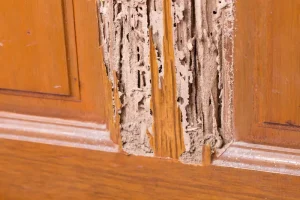
Purchasing a home is an exciting milestone, but underlying termite issues can quickly turn that dream into a stressful situation. However, termites don’t have to be a deal breaker. With the right knowledge, you can confidently move into a home that has a history of termite damage, while still protecting your investment. After all, maintaining the value of your new home is one of the top priorities for any homeowner.
Termites are silent destroyers, capable of causing serious structural damage long before they’re even detected. Since colonies can take years to mature, previous owners may not have realized the extent of the problem until it became significant. That’s why it’s important to make termites part of your home inspection checklist. Trained inspectors know how to spot both active termite activity and signs of past repairs.
Let’s dive into the key things you need to know about termites, damage, and protecting your home’s future.
Buying a Home With Termite Damage: Smart Steps to Take
Concerns about hidden damage and future infestations are completely valid when termites are in the picture. If an active infestation is found, immediate treatment is necessary. However, if the damage is old and has already been repaired, the focus shifts to prevention, so you can ensure the termites don’t return.
As part of your home buying process, you can request a specialized termite inspection, often referred to as a wood-destroying insect (WDI) report. This report provides crucial insights into any past or ongoing termite activity, helping you take the right steps toward a secure home.
It’s also important to remember that termites can have implications for your homeowner’s insurance. Some insurance providers require proof, like a WDI report, showing that your property is free of active infestations.
How to Identify Termites: What Do They Look Like?
Termites are small and often mistaken for carpenter ants, but there are a few clear differences. Termites have straight antennae, thicker waists, and wings that are equal in size. Their color typically ranges from pale white to light brown.
In Georgia, the most common species is the Eastern subterranean termite. These termites have a dark brown to black body with translucent, whitish wings that make them easy to confuse with other pests if you don’t know what to look for.
Is Buying a Home With Termite Damage a Good Idea?
Whether or not you should move forward with a purchase largely depends on the severity of the damage. If the structural damage is too extensive, the cost and risk may outweigh the benefits. Before making a decision, it’s wise to bring in a qualified termite control specialist to perform a thorough inspection. You should also have a structural engineer assess any compromised areas to confirm that the home’s foundation and framework remain sound.
Additionally, inspection results could open the door for negotiation, whether it’s requesting repairs before purchase or securing a lower price to account for the cost of restoration.
Spotting the Signs of Termite Damage
When termites move in, the destruction they leave behind can be overwhelming. These relentless pests chew through wood, flooring, and even wallpaper, quietly weakening your home’s structural strength. Keep an eye out for these common signs that termites may have been hard at work:
- Hollow-sounding wood
- Buckling or warped floors
- Peeling paint that looks like water damage
- Tiny holes in drywall
- Mud tubes on exterior walls
Is Termite Treatment Safe for Your Home?
When applied by a licensed professional like Active Pest Control, termite treatments are carefully designed for homes in mind. We understand that homeowners prioritize health and environmental concerns when it comes to pest control solutions. That’s why we use eco-friendly, GreenPro-certified products for our termite treatments.
Our trained technicians are skilled at applying these treatments in a way that specifically targets termites while reducing any potential impact on your household, pets, or surrounding environment.
The Right Way to Keep Termites Out of Your House
Trying to take on termite prevention with DIY methods isn’t enough when it comes to protecting your home. While simple fixes like removing wood-to-soil contact and addressing moisture issues can help, true prevention demands a professional approach.
Partnering with a termite expert, such as Active Pest Control, means you’ll benefit from a full range of preventative measures, including:
- Inspections to identify vulnerabilities.
- Installation of termite barriers and monitoring systems.
- Eco-friendly treatments to create a protective shield around your home.
Guard Your New Home With Professional Termite Protection
When it comes to termites, timing is everything. Early detection and professional treatment can be the difference between a manageable issue and major damage. Don’t give termites the chance to jeopardize your future home’s value.
At Active Pest Control, our complete termite control services are designed to deliver lasting results and peace of mind. Our licensed specialists will perform detailed inspections, pinpoint any termite activity, and apply targeted, eco-friendly treatments certified by GreenPro. We’ll also create a custom protection plan tailored specifically to your property and needs, ideally before your closing date, so you can move in with confidence.
Ready to get started? Contact our team today!
Termites and Your New Home: What Every Buyer Should Know in Georgia
Serving Your Pest Needs for Over 35 Years Across Georgia
McDonough | Conyers | Lawrenceville | Alpharetta | Marietta | Columbus
Newnan | Locust Grove | Rome | Atlanta | Brunswick | Byron | Augusta | Savannah
Home » Termites and Your New Home: What Every Buyer Should Know
